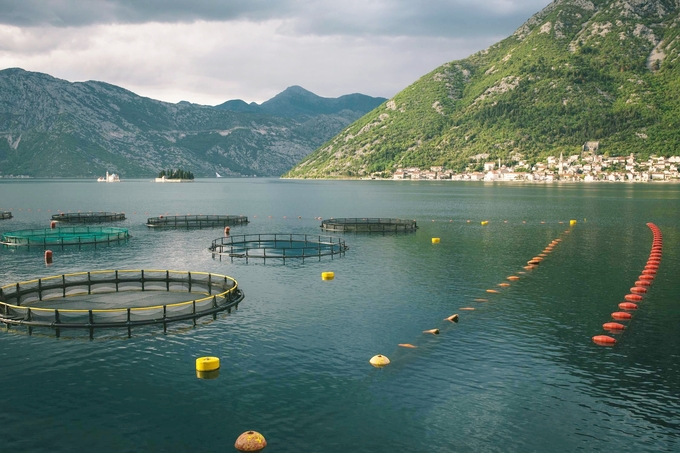June 22, 2025 | 14:14 GMT +7
June 22, 2025 | 14:14 GMT +7
Hotline: 0913.378.918
June 22, 2025 | 14:14 GMT +7
Hotline: 0913.378.918
According to new research from the University of Michigan (U-M), humanity can exploit more food sources from the ocean to meet global demand while reducing the negative impact of the marine farming on biodiversity, but this can only be achieved if this industry is carefully managed.
Deqiang Ma, the main author of the study and a doctorate researcher in the environment and sustainable U-M, said, “We can develop sustainable mariculture. With a reasonable planning strategy, we can both preserve marine species and meet the needs of expanding marine farming globally”.

It is crucial to make full use of the increasingly deep understanding from a wide variety of fields, from climate change science, and economy to marine farming. Photo: Vadim Braydov.
Mariculture accounted for approximately one fifth of the total aquaculture production in 2020 and is now an important source of protein for billions of people. As the demand for aquatic products increases, production is promoted to strengthen output as a response. To predict the impact of this boom, Ma and the international research team have built a model to assess the effects of marine farming on more than 20,000 marine species.
The team has used this model to measure the current impact of the industry and forecast changes to 2050, depending on the type of aquatic products raised and the farming location. The model also considers two different climate scenarios, called RCP 4.5 and RCP 8.5, assuming the different levels of heating and emissions of greenhouse gases. In the best scenario, the construction of farms in the most environmentally friendly areas brings promising results for both farmed mollusks and fish.
On the contrary, the worst scenario shows alarming results. If new farms are built in areas with the biggest negative impact on the biodiversity, the consequences may be four times higher than choosing a random farming location.
“This emphasizes the importance of strategic planning and the need to cooperate with experts from many fields to come to a comprehensive view. Taking advantage of the increasingly deep understanding from many different fields, from climate change science, and economy to marine farming is extremely important. All of these factors need to be synthesized so that we can make accurate forecasts,” said Neil Carter, senior author of the research.
The research team emphasizes that this study is only the first step towards a more sustainable future for marine farming. They also note that the model can continue to be improved by adding new data. One thing to add is that there is no common plan for all situations, for instance, farm development strategy in the South Pacific may not be suitable for the French coast.
Even in the most optimal scenario, there are still trade-offs. To give an example, the development of marine farming negatively affects sea mammals such as whales, seals and sea lions in all cases. By understanding these limitations and trade-offs, researchers and policymakers will be able to make better plans and wiser decisions.
“With specific knowledge, we can see that the expansion of an industry does not necessarily lead to negative impacts on the environment. Therefore, policy and community makers need to cooperate to find a way to develop sustainable mariculture, minimize negative impacts and prioritize conservation of marine biodiversity,” Carter said.
The consolidation of the Ministry of Agriculture and Rural Development and the Ministry of Natural Resources and Environment into the Ministry of Agriculture and Environment can bring many advantages to the field of marine farming.
This field was previously under the overlapping management between the two ministries. The Ministry of Agriculture and Rural Development was responsible for the development of the fisheries sector, while the Ministry of Natural Resources and Environment managed marine resources, licensing water use and environmental protection. This separation sometimes makes it difficult for businesses, cooperatives and farmers when they need to solve problems related to the farming waters.
Vietnam has a great advantage in developing "green" and sustainable mariculture thanks to having a long coastline, favorable natural conditions and abundant aquatic resources. In the context of the government’s strengthening of marine economic strategies, the mariculture industry has great opportunities to develop in the direction of modernity with environment-friendly approaches that increase economic value.
Translated by Samuel Pham
![Turning wind and rain into action: [9] Digitizing hydrometeorological data in response to climate change](https://t.ex-cdn.com/nongnghiepmoitruong.vn/608w/files/news/2025/06/17/z6704423696987_15fd32ffc26d590d204d520c9dac6786-nongnghiep-165943.jpg)
(VAN) Farmers have begun accessing hydrometeorological applications to adjust their cropping schedules, aiming to ensure productivity and adapt to climate change.
![Turning wind and rain into action: [8] Real-time salinity detection and early warning technology](https://t.ex-cdn.com/nongnghiepmoitruong.vn/608w/files/news/2025/06/17/z6704423696987_15fd32ffc26d590d204d520c9dac6786-nongnghiep-151127.jpg)
(VAN) Thanks to the integration of modern hydrological-hydraulic models, remote sensing technologies, and artificial intelligence, the accuracy of hydrological forecasting has significantly improved.
![Turning wind and rain into action: [7] Early disaster warnings help marine farmers minimize losses](https://t.ex-cdn.com/nongnghiepmoitruong.vn/608w/files/news/2025/06/17/z6704423696987_15fd32ffc26d590d204d520c9dac6786-nongnghiep-142942.jpg)
(VAN) In recent years, thanks to early disaster warnings and forecasting, marine farmers in Khanh Hoa province have been able to reduce risks and losses, thereby improving production efficiency.
![Turning wind and rain into action: [6] ‘Four on-the-spot’ disaster management software](https://t.ex-cdn.com/nongnghiepmoitruong.vn/608w/files/news/2025/06/17/e5a48259d6a262fc3bb3-nongnghiep-183800.jpg)
(VAN) By simply activating the scenario on the disaster management software, the relevant authorities immediately know how many households need to be evacuated, where to evacuate them to, and by what means of transportation…
![Turning wind and rain into action: [5] Hue applies modern technology in disaster forecasting](https://t.ex-cdn.com/nongnghiepmoitruong.vn/608w/files/news/2025/06/17/z6704423696987_15fd32ffc26d590d204d520c9dac6786-nongnghiep-093938.jpg)
(VAN) In Hue city, modern technology has recently been applied in meteorological and hydrological forecasting and warning, helping to reduce the damage caused by natural disasters.

(VAN) A cutting-edge farming technique being implemented on an experimental ranch in Arizona's Sonoran Desert has already saved a billion gallons of water over five years, according to Civil Eats.

(VAN) Poultry and pig production and the environment can be boosted through enhanced water technology, according to new research.